Topic: Drill and Training
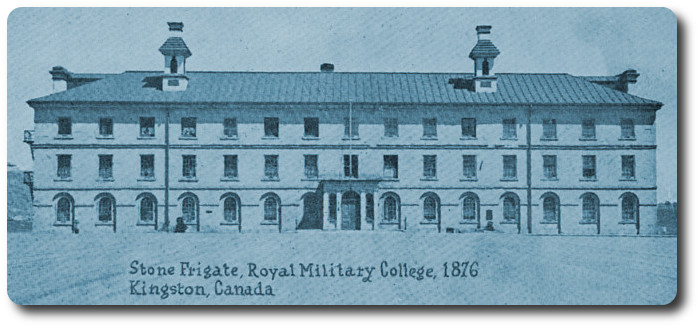
RMC Kit Layout 1926
From the January, 1926, Standing Orders of the Royal Military College of Canada, come these illustrations of the kit layout required of Cadets for inspections.
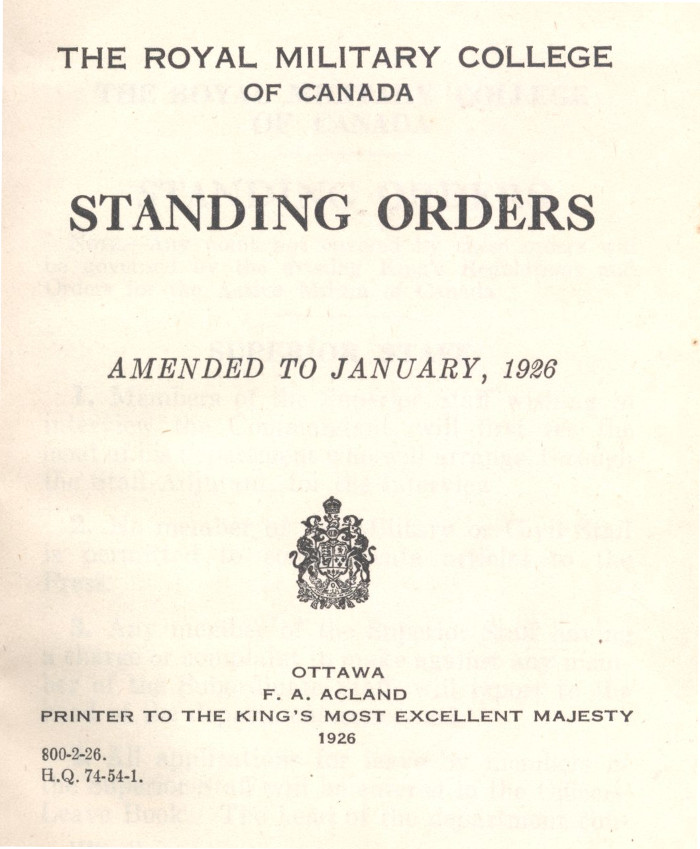
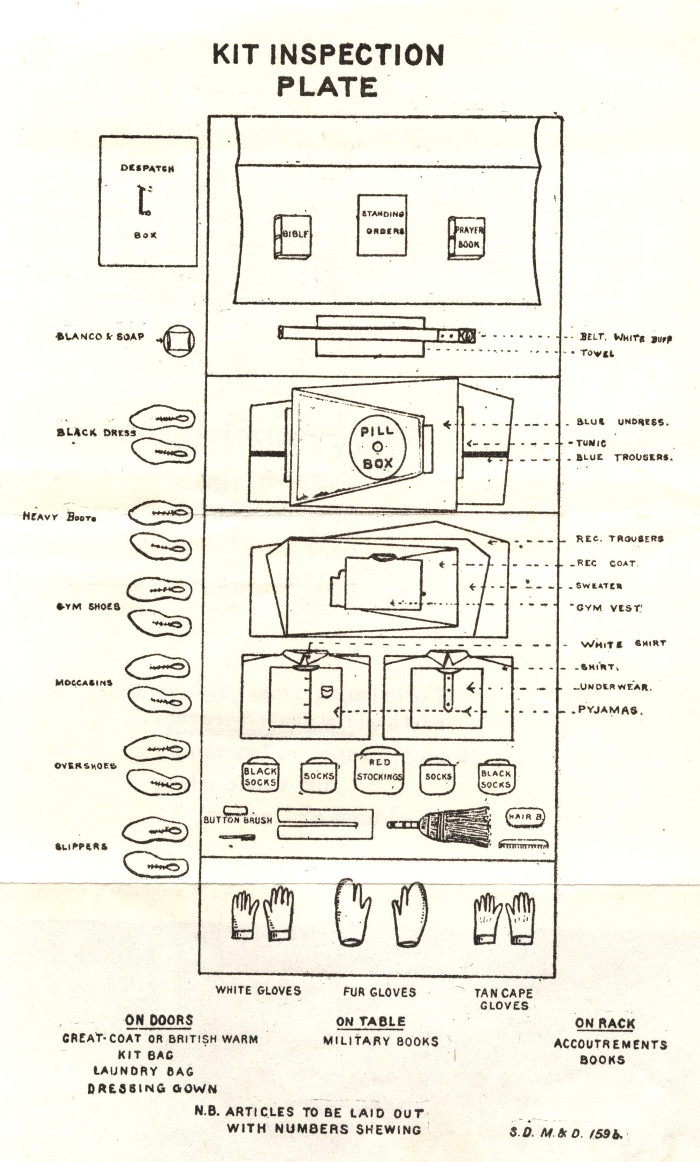
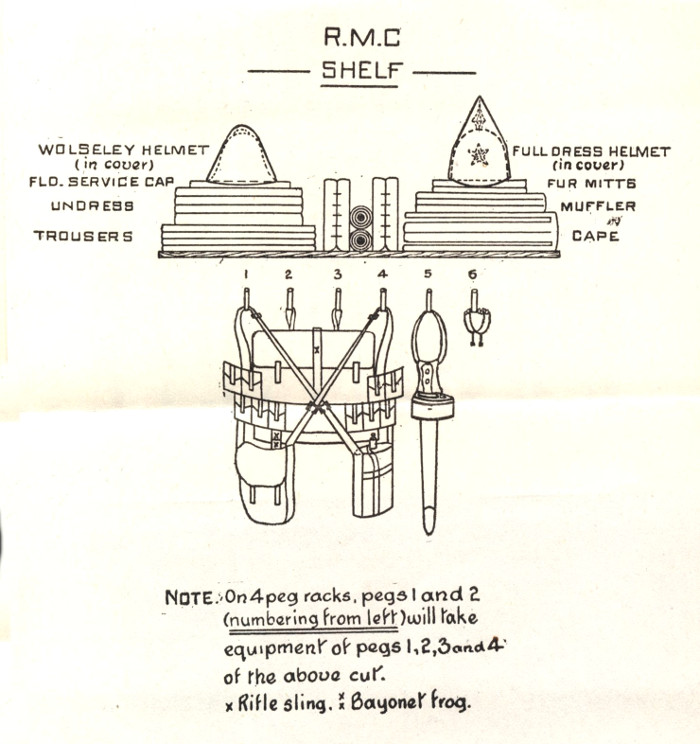

From the January, 1926, Standing Orders of the Royal Military College of Canada, come these illustrations of the kit layout required of Cadets for inspections.



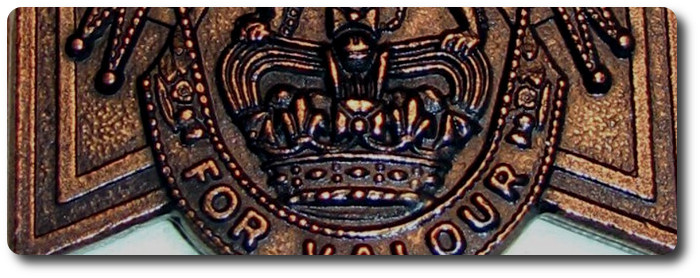
The Spokesman-Review, Spokane, Washington, 4 February 1918
(Via Scribner's)
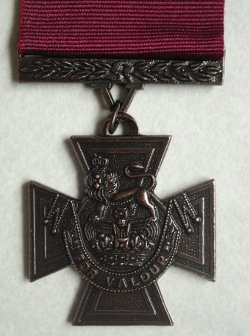 The Victoria Cross, one of the most coveted of military decorations, and the most rarely conferred, was instituted during the Crimean war, and is made from the bronze of captured cannon. It is not a Maltese cross, but a cross pattee, its obverse center bearing the royal crest of a lion passant, gardant, upon the British crown, above a ribbon inscribed "For Valour." On the reverse if a circular space reserved for record of the act that gained the decoration. The name and rank of the recipient are on the bar above. The ribbon is red for the army and blue for the navy.
The Victoria Cross, one of the most coveted of military decorations, and the most rarely conferred, was instituted during the Crimean war, and is made from the bronze of captured cannon. It is not a Maltese cross, but a cross pattee, its obverse center bearing the royal crest of a lion passant, gardant, upon the British crown, above a ribbon inscribed "For Valour." On the reverse if a circular space reserved for record of the act that gained the decoration. The name and rank of the recipient are on the bar above. The ribbon is red for the army and blue for the navy.
The cross was instituted in 1856, but its award was made retroactive, so that it happened that the first Victoria Cross was awarded for an act of valor on June 21, 1854. The recipient was "Mr. Lucas," then mate on board H.M.S. Hecla. A live shell fell on the deck of the Hecla and, without an instant's hesitation, Mr. Lucas picked it up and threw it overboard.
The Victoria Cross is a dignified piece of sculpture, dominated by a lion worthy of Barye. Its possession, like those of most of the British crosses, confers a sort of military "degree," in certain cases, permitting the wearer to write V.C. after his name. Moreover, the cross carries with it an annuity of £10, which, in case of extreme want, may be increased to £50. Every recipient of a Victoria Cross is the ward of a grateful nation.

From: Field Service; The Sydney Morning Herald, Sydney, Australia, 11 May 1855
(From the Household Words)
The management of battering trains requires great energy, patience, and attention from the artillery officer. First, he had to consider the quantity of ordnance—six guns being used to every four howitzers or mortars, besides allowing for spare guns; then, the ammunition; and next, the means of transport. With regard to the ammunition, it is stated that at the siege of Ciudad Rodrigo, in six days, eighteen hundred and twenty-five barrels of powder were expended; at Badajoz, in eight days, two thousand two hundred and seventy-one barrels; and at the two sieges of Saint Sebastien, five thousand and twenty-one barrels. As to shot, the average per gun may be (this is speaking roughly) about five hundred; and of shells, one hundred and twenty; but the general conclusion from former sieges is that a breach, one hundred feet wide, can be made by the expenditure of ten thousand six hundred twenty-four-pounder shot, at five hundred yards distance. With a commanding position, much less will suffice.
Upon enquiring into the execution done, we find, from elaborate experiments tried in eighteen hundred and thirty-four at the great artillery school at Metz, a thirty-six pounder, with only one-third charge, at one thousand yards, penetrated twelve inches into good rubble masonry, thirty-one inches into sound oak, and nearly six feet into a mass of earth, sand, and clay. An eight-inch shell penetrates twenty-three feet into compact earth. One thirteen-inch iron mortar, at an angle of forty-five degrees, with a charge of twenty-five pounds, ranged four thousand eight hundred and fifty yards. Weak powder is sensibly improved by heating it, with proper care. Exposure to the sun is useful.
Double shotting, which is chiefly practised in the navy, may be safely tried at short distance with heavy guns. It would seem easy to sink a ship by hitting her below water; but the fact is, the resistance of the water is so great, that a shot can hardly penetrate it; and the only way to damage the ship, would be to catch her as she heels over. Steamers, with their machinery below the water-line are as safe as sailing vessels; even many holes in the funnels are of slight consequence.
The smooth bored percussion musket will fire sixty rounds in thirty minutes, and carry two hundred yards. The carbines used by the artillery and cavalry carry one hundred and fifty yards. These however, are nothing to the new rifle muskets and carbines with Minié balls which are good at eight hundred to one thousand yards. Artillery do not need carbines carrying beyond three hundred yards, as their heavy ordnance effectually keep the enemy at a respectful distance.
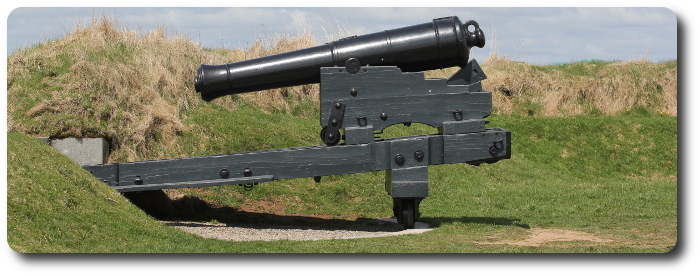

The Border Cities Star, Windsor, Ontario, 1 March 1924
By Deanna Van Luven
Since the formation of the earliest military and naval organizations in the dim, dark ages, it has been the custom to deck out the fighting units with badges, banners, crests and similar signs.
In heathen times the warring tribes would carry some sacred sign into battle, usually an image of their particular god, thus giving them courage and inspiration.
Down through the ages the custom continued, and when the science of military strategy and tactics became more developed these signs became rallying points of armies and the various divisions of the fighting forces.
It is recorded that the early Egyptians, Assyrians, Jews and Persians carried banners. These would generally consist of cloths, varying in size, shape and colors, or figures of birds and animals.
The armies of the early Egyptian kings carried a fan-shaped design bearing the initials of the reigning sovereign, while the Roman eagles are equally familiar in the pages of history.
The word "flag," which is of Teutonic origin, meaning "a piece of cloth waving in the wind," was adopted to distinguish the banners flown at sea. It was later used as a term for both naval and military banners.
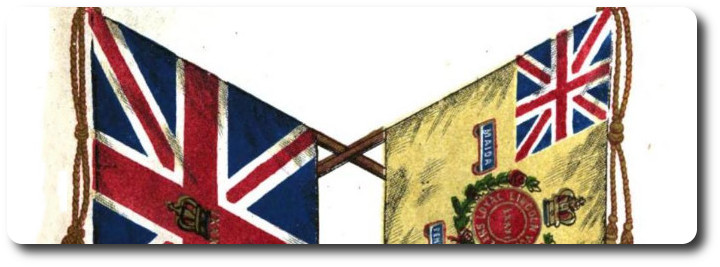
To come down to the Middle Ages, the days of the feudal barons, each of the lordly landowners adopted a particular banner, and his followers wore distinctive badges. In the days of the early Crusades the armies were a riot of colorful banners, crests and designs.
The King's banner was carried by the regiments of "mercenaries" when they were introduced, and the men wore the King's badges.
Although St. George had been the patron saint of England from the earliest times, it was not until the reign of Edward III that this was officially recognized, and Henry V was the first to bear a banner with the cross of St. George embodied thereon. St. Andrew was adopted as the patron saint of Scotland about A.D. 750.
When James VI of Scotland became James I of England he ordered the cross of St. George and the celtire of St. Andrew to be combined, thus making the first Union Flag. It was then commonly known as the "Jack" after Jacques, the French version of the King's name. This flag was carried by the British armies, with some slight variations, and with the exception of the Commonwealth period, until the year 1800, when the celtire of St. Patrick of Ireland was added to then design.
The flags assigned to the various regiments in the British army are known as "Colors," "Standards," or "Guidons," according to the branch of the service concerned. The latter two terms concern the cavalry, while "Colors" are borne by infantry only. Regiments of rifles, artillery and hussars carry no colors or standards.
In the infantry regiments two distinct colors are carried, the first being the King's Colors, a "Union Flag," with the cypher of the King and the name of the regiment enscribed in the centre, and the other being the Regimental Color, which is of variable design.
Regimental Colors for the various infantry regiments are as follows: English, cross of St. George; Scotch, yellow; Irish, green (non-existent), royal regiments always blue; and special regiments, corresponding to uniform facings. The crest of the regiment is enscribed in the centre, and encircled by wreaths of entwined rose, thistles, shamrocks or oak leaves as the case might be. The wreath is of maple leaves in Canadian units.
Battle honours are scrolls with the names of "actions" embroidered on them and are awarded to those regiments which have specially distinguished themselves.
Although rifle regiments and certain other branches of the service carry no colors their honors are inscribed on their badges. "Rifles" were originally scouts and skirmishers, and their particular role made the carrying of colors impossible. Later, when formed into units the old tradition remained. The fact that batteries of artillery have no colors may possibly be traced back to the ancient customs of the Prussians in having carved chariots accompanying their field troops instead of banners.
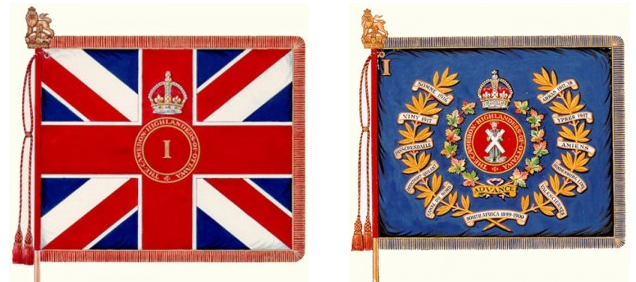
Colors are usually carried by two subalterns (lieutenants or second lieutenants), with an escort of three N.C.O.'s or men with fixed bayonets. The colors of a regiment must not be confused with the regimental "colors," which are really "club" designations.
Since 1879 colors have not been carried in action by British regiments. In that year, in one of the campaigns against savages, two officers lost their lives while endeavouring to save the colors. It was then decided an unnecessary sacrifice in savage warfare, and the custom has not been revived to the present. It is contended by military authorities that their use would be extremely valuable in civilized warfare, especially in the assault, as they would serve as distinguishing marks and guides where a large body of troops are working together. This, of course, would apply in a campaign of the "open" variety only. They were used to this end in the Russo-Japanese war.
At all times the colors are paid the highest honours, as they are consecrated, and are the epitome of the history of the regiment concerned. The represent Honor, Death and Glory, and the self-sacrifice of thousands of the finest men of a nation. They are a symbol of the trust placed in that regiment by the king.
At the conclusion of the Great War, 1914-18, a special King's Color was presented to all overseas units taking part therein. The late King Edward VII presented a similar banner to the Royal Canadian Regiment upon the conclusion of the South African War, 1899-1902, and an elaborate ceremony is still carried out by that regiment on Paardeburg Day, the 28th of February (sic) of each year, and this color is "trooped" on this anniversary.
Many old and historic colors now repose in St. Paul's Cathedral, London, England, battle-scarred and torn, but honored by the entire nation. In Canada the majority of the colors of overseas units in the C.E.F. have been "hung" in various churches, and those of one of the units formed in this district may now be seen in the vestry of All Saints' Church, Windsor.
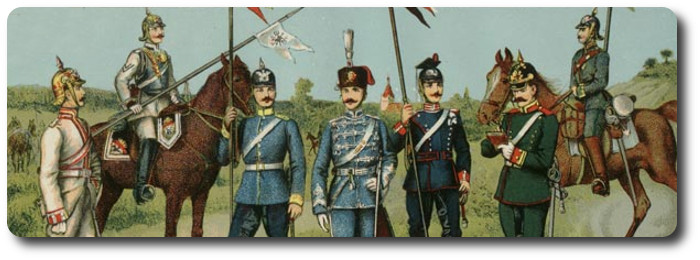
The Montreal Gazette, 2 February 1909 (Special Cable Service.)
Berlin, February 1.—A duel with pistols was fought today near Frankfurt-on-Main by Baron Von Oertzen, an infantry captain, and Lieut. Von Stuckrad, of the reserves. The two were formerly close friends until Lieut. Stuckrad, during Captain Oertzen's absence during the manoeuvres some time ago, eloped with the latter's wife. The woman's parents tracked the couple to New York and traied vainly to persuade their daughter to return. Capt. Von Oertzen subsequently obtained a divorce, but this had hardly been granted when Lieut. Von Stuckrad quarreled with the woman, whom he forsook, leaving her in America, and returned to Krueznach, where his father, a retired Burgomaster, resides. After the duel Von Poertzen surrendered himself to his superiors. Probably the only penalty imposed on him will be a formal reprimand.

More to the story, as reported in various paper, including the Mill Valley Independent of Mill Valley, Marin County, California (Number 43, 23 April 1909):
A sequel to the romance of the Baroness von Oertzen and Herr von Stuckrad, who eloped to New York last August, has come from the Stadtwald. near Fraukfort-on-the-Main, where the baroness’ husband killed Herr von Stuckrad in a duel, a Berlin correspondent of the Philadelphia Ledger says. Baroness von Oertzen is believed to be in New York.
Baroness Rudolph von Oertzen and Herr von Stuckrad were friends when in garrison together at Neu-Ruppin, and their parents and both their families were also bound together in ties of friendship. Baron von Oertzen was married to the beautiful daughter of Herr Malm, the great manufacturer of Rostock. Herr von Stuckard was a frequent guest at the house and while maintaining outward appearances of friendship for the baron, made love to the baroness.
Last summer the baron was obliged lo leave home to attend the maneuvers with his regiment. Herr von Stuckrad. who had quitted military service for private reasons, remained at Neu-Ruppin. When the baron returned from the maneuvers he discovered that his false friend had persuaded his wife to elope with him to America. The two were trailed to Bremen and thence to New York. The parents of the baroness, who had crossed the Atlantic by the next ship, found her with Stuckrad and did their utmost to persuade her to return home, but without success. The baroness refused to leave Stuckrad or return to her husband. Baron von Oertzen initiated divorce proceedings on the ground of desertion. The case was tried in December and terminated in his favor.
Scarcely had the divorce decree been pronounced when Stuckrad quarreled with the baroness, left her and returned to his home at Kreuznach, where his father, a retired general, is burgomaster. Baron von Oertzen, on hearing of his return, sent his seconds with a challenge to a duel, which Stuckrad immediately accepted, the conditions being pistols at twenty-five paces’ distance and three rounds. A secluded spot in the Stadtwald was selected as the place where the deadly quarrel of the two men could he fought out without interruption.
Baron von Oertzen arrived on the scene with two brother officers, who acted as seconds, and a physician. A few minutes later Herr von Stuckrad drove up from another direction with his two seconds. The seconds measured the distance and the combatants placed themselves in position. Both took careful aim and the shots seemed to be simultaneously. Baron von Oertzen’s bullet lodged in Stuckrad’s body, inflicting terrible injuries to the internal organs, Stuckrad’s shot missed its aim and the baron remained standing uninjured. After witnessing his opponent’s death the baron, accompanied by one witness, drove to Frankfurt-on-the-Maln to report himself to the military authorities, while the other witnesses of the fatal duel removed Stuckrad’s body to the nearest mortuary.
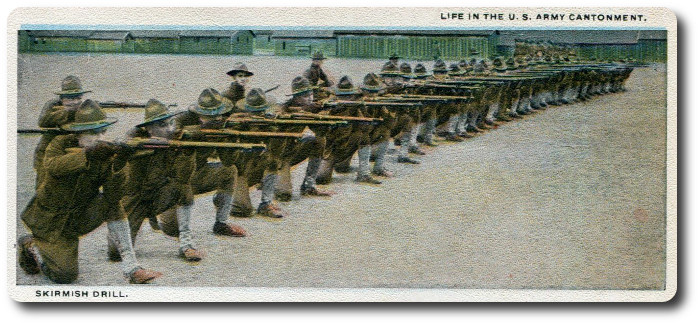
The best safeguards against disease, either in the army or out of it, are soap and sunshine.
Spokane Daily Chronicle, Spokane, Washington, 1 September 1917
When large numbers of men are assembled in camp it is necessary for the good of all that strict rules of personal conduct and sanitations should be enforced. These rules are by no means a hardship. They are a protection. By insisting on strict obedience to these rules, the diseases which once took so heavy a toll in nearly all military camps have been brought under control; some have been practically eliminated.
Suppose you were asked to make a choice; either to live under conditions in which smallpox, typhoid fever, diarrhoea, dysentery and cholera flourish; or to live under strict regulations, which make these diseases far more of a rarity in military than in civil life. Your good sense would lead you to choose the latter. Bear this in mind. See to it that you cooperate with enthusiasm in the measures that will be taken to keep your camps clean, comfortable and healthful.
One of the pests of camp life, if perfect cleanliness is not observed, is the presence of swarms of flies. Flies are not merely annoying. They are dangerous. Somebody has said, with perhaps a slight exaggeration, that to soldiers they are more dangerous than bullets.
The best way to keep flies away from camps is to destroy the places where they breed and feed; in other words, keep the camp spotlessly clean. For this reason the daily "policing" (or cleaning up) of the camp is a matter of first importance.
This is a duty which an experienced soldier usually performs with more interest and thoroughness than the raw recruit, for he realizes its importance.
The best safeguards against disease, either in the army or out of it, are soap and sunshine.
The good soldiers is almost "fussy" in the care of his person, his clothing, his bedding and his other belongings. Personal cleanliness includes using only your own linen, toilet articles, cup and mess kit. Most annoying skin troubles and such diseases as colds and infectious fevers are often passed from one person to others by using articles in common.
In the training camp there will be plenty of shower baths, and you will, of course, make free use of them. If in temporary camps or at any other time you cannot obtain a bath, give yourself a good, stiff rub with a dry towel. Twice a week, or oftener if necessary, your shirts, drawers and socks should be washed and fresh underclothes put on. In case it is necessary to sleep in your underwear, as it probably will be, put one aside to wear at night, so that you will always feel fresh and clean in the morning.
The scalp should be thoroughly cleaned about as frequently as the rest of the body. This will be made easier if you keep your hair cut short.
The teeth should be brushes at least once a day; twice a day is better. Neglecting this practice will cause decay of the teeth, resulting in failure to chew food thoroughly and probably ending in stomach troubles.
The medical corps of the army and your own officers will use every means within their power to safeguard and improve your general health. Within recent years better methods of medical supervision have greatly reduced the losses and the disabilities due to warfare.
But the responsibility for keeping yourself in good health can not rest wholly upon your officers. Just as in civil life, you are expected to use a reasonable amount of good sense in looking after yourself. You will do this partly because it adds to your own comfort and safety. You will take care of yourself, also, because it is a duty that every soldier owes to the country. You will have plenty of fresh air, exercise and good food, which are after all the chief essentials of good health. It should be a comparatively easy thing for you to look after the smaller things.
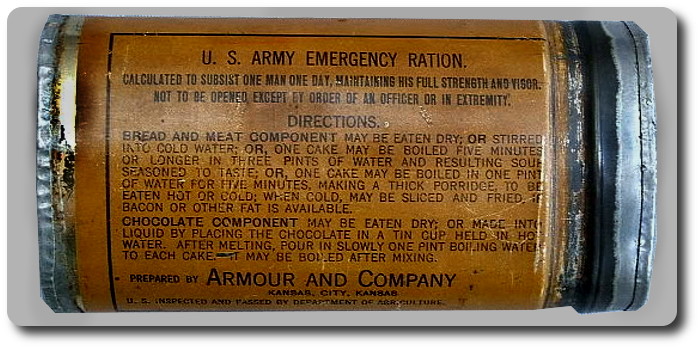
Coffee, tea, chocolate, cocoa, and so on, are indispensable, and in some armies, such as the French, light wine is furnished as part of the regular diet of the soldier. The Germans prefer beer.
The Spokesman-Review, Spokane Washington, 12 January 1918
As long as an army is fed it can fight, provided, of course, that its guns are fed also. We hear more about the food of the guns than about that of the men, but the latter is the more important of the two, as was shown recently when come of our boys in France, having no guns, fought their way out of German captivity with their fists.
The improvements in army food also keep step with those in powder and projectiles. High-powered powder and high-concentration foods are the twin winners of modern battles. Some of the foods used as "emergency rations" are curious indeed, and some possess astonishing powers of nourishment locked up in a very small space. Modern improvements and discoveries in the preservation and concentration of foods have, perhaps, been as effective in extending the range of military campaigns, accelerating the rapidity of strategic movements and increasing the power of sudden blows as any advance in armament.
Meat stands, as it always has done, at the head of the list of essential foods for an army. Bread, in its various forms, comes next. Fruits and vegetables must generally be furnished in preserved and concentrated forms in which shape they supply some of the sugar, which is a very essential element of an army's rations. Coffee, tea, chocolate, cocoa, and so on, are indispensable, and in some armies, such as the French, light wine is furnished as part of the regular diet of the soldier. The Germans prefer beer.
It is asserted that tea is the most sustaining of all the army beverages because it is especially effective in arresting waste of the bodily tissues. It ranks next to milk in this quality. The Russians are the great tea drinkers, and the English are fond of it, but it has never had the popularity of coffee with American men. The Russian army has many forms of compressed tea in its rations, and it is averred that the Russian soldier could hardly fight without tea. One of the illustrations shows a round disk of compressed tea for the Russian army made of whole leaves of prime quality, and weighing three pounds, yet not too large to be slipped into a coat pocket. Other forms in which the tea is preserved are bars, slabs, and balls.
There is an emergency meat ration called the "chain-shot ration" on account of its form. It is used by the Belgians, French and Germans as a winter ration, being too oily for summer use, and L. Lodian says of it in the Scientific American that it "is the finest combination of sustaining and heating qualities known among the meat foods." Each ball is a chain constitutes one complete ration.
But the celebrated "pea-sausage," or erbswurst," of the German army gets a setback on the same authority, for it is said to be "about as unsatisfactory a concentrated ration as any extant, and is actually inedible when uncooked, being of a nauseating, bitter and raw flavor."
The notable ration of the Swiss army is "white chocolate," which consists of nothing but cocoa butter and sugar, the brown parts of the cocoa being removed. Moulded into a cake it resembles in color and gloss a billiard ball. It is more nutritious than brown chocolate.
The emergency ration of our own army, as prepared for the trenches, consists of chocolate tablets and packets of parched cornmeal. The latter seems to have been suggested by the parched corn of the Indians who often, when on the warpath and compelled to undergo great fatigues, subsisted for days on this food alone. Still, as a ration, the pemmican which some of the American tribes ultimately adopted, is said to be much superior in sustaining power to the cornmeal, or any other cereal food, since it contained chopped meat together with grain.
The Italian rations contain chocolate stuffed in sausage-like cases and a kind of plum duff, stuffed with raisins, and inclosed in a long membrane, in which it can be cooked with steam, while the empty case will serve for a tobacco pouch.
The Italian duff is said to be more nourishing than the British plum pudding. A kind of "spotted dog" is prepared with dark Italian wines instead of water, while rich nut meats are used for shortening. This recalls the rye hardtack of the Russians, in the making of which beef blood is emplyed instead of water.
But the nearest approach to the ideal emergency ration is said to be "the unsalted, sun-dried, paper-thin meat sheets" issued to some of the Latin American armies. It can be folded up and pocketed like paper, and is ready to be eaten withour preparation of cooking. Similar sun-dried meats in sheets are used by the soldiers of some Asiatic and African tribes.

The Pittsburgh Press, 26 July 1903
(From the St. James Gazette)
 January 29th is the anniversary of the institution of the soldiers most precious decoration—perhaps the most precious decoration in the world—the Victoria Cross, for it was instituted by Her Majesty, the late Queen Victoria, on the 26th day of January, 1856, and so is not quite 50 years old. While it is the most prized of all the decorations and orders an Englishman can win, it is also the most democratic decoration in the world, although it is the official badge of an actual personal courage and daring, it has no concern with rank, long service or wounds, and it may be worn by one who has been only a few months, or even weeks, in the army, while other who have spent their lives in the service and gained rank and other decorations may not possess it.
January 29th is the anniversary of the institution of the soldiers most precious decoration—perhaps the most precious decoration in the world—the Victoria Cross, for it was instituted by Her Majesty, the late Queen Victoria, on the 26th day of January, 1856, and so is not quite 50 years old. While it is the most prized of all the decorations and orders an Englishman can win, it is also the most democratic decoration in the world, although it is the official badge of an actual personal courage and daring, it has no concern with rank, long service or wounds, and it may be worn by one who has been only a few months, or even weeks, in the army, while other who have spent their lives in the service and gained rank and other decorations may not possess it.
It may be worn by a private soldier or a field marshal, and on the roll of the heroes' names are to be found almost every rank in both the services, for the winning of the cross is possible to any one, as it was granted "as a reward for conspicuous bravery or devotion to the country in the presence of the enemy,' or as the inscription upon it records, "For Valour.'
The Victoria Cross had its birth during the Crimean war, when Queen Victoria felt that some recognition of the personal daring and heroism of her soldiers in that terrible struggle was needed. The royal warrant clearly lays down the conditions under which the cross may be won, but the whole of them may be summarized in one sentence. `For conspicuous bravery or devotion to the country in the presence of the enemy.`
There are not many who are unfamiliar with the appearance of the cross, but for the benefit of those who have only seen it in photographs or pictures it may be said that it is about an inch and a half wide and has in the obverse center, a crowned lion, underneath which is an scroll bearing the words, "For Valour.' It is attached to a bar on which is a spray of laurel leaves and is suspended by a broad ribbon, which is blue for the naval service and dark red for the military. Both the cross and the bar are made from bronze which formerly formed part of some of the Russian guns captured during the Crimean was and complete with the ribbon and pin weighs just under an ounce, or 342 grains, to be exact. It is engraved with the name and regiment of the recipient, as well as the date on which he won it, and as soon as this is done it is dispatched from the makers to the sovereign to bestow upon the hero.
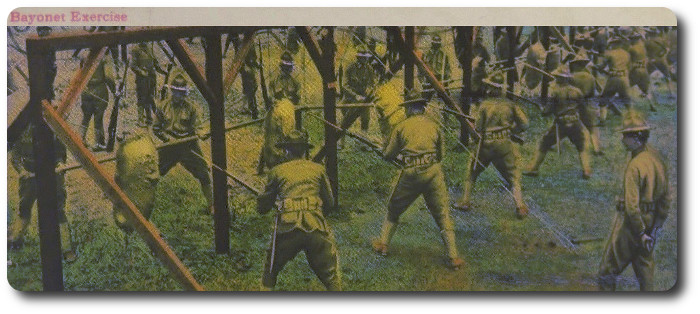
"That man remains the fundamental instrument in battle, as as such can not be replaced by any imaginable instrument short of a more perfect thing than the human body, including the mind."
The Spokesman-Review, Spokane, Washington, 14 February 1922
By Associated Press
Washington, Feb 13.—The "dough boy" with a bayonet still is the "basic combatant" unit in battle. This is the virtually unanimous judgment of the American army, officially rendered in cold post-war analysis. Aircraft, tanks, bombs, machine guns, cannon, merely are valuable auxiliaries for the infantry "man in the bulk," armed with rifle and bayonet, and each foot soldier armored only by his "own agility" and a steel helmet.
For "battle is normally determined by physical encounter with the bayonet or the fear thereof," the official conclusion of the army made public today asserted. It is based on answers to a widespread "questionnaire sent recently through the war department bureaus and out through corps and divisional areas, even down to commanders of regiments, to lay the ground work for the doctrines of tactics and of training on which post-war building of the army shall proceed."
The answers were unmistakable. There has been no change—soldiers who fought in France believe in the age-old-gospel of "cold steel" in war. As it was with Cromwell's grim host, striving for victory "with push of pike," with Napoleon's old guard that "dies but never surrenders," with Pickett's flower of the south" at Gettysburg, so it was with Pershing's "buddies" in France. Cold steel was the ultimate arbiter of battle.
The conclusion follows "an exhaustive study of the influence that modern scientific development will have upon the technique of warfare, especially with regard to aviation, motor transport and tanks." Chiefs of all combat branches had their say on the questionnaire, designed to bring out the best present military thought," both on basic principles and as to changes in fighting technique necessitated by new weapons.
As the research work goes on tests will be made "to solve debatable questions." Among these is the "comparative value of bombing planes and fixed heavy guns in sea coast defences."
"It is possible at this time," the statement added, "to announce the conclusion of the war department resulting from the answers to the basic question as to which there was substantially unanimous agreement. It is concluded, and doctrines of tactics and of training will be based accordingly:
"That man remains the fundamental instrument in battle, as as such can not be replaced by any imaginable instrument short of a more perfect thing than the human body, including the mind."
"That man in the bulk—meaning the greater portion of the armed forces—fights with the greatest freedom of action and with greatest efficiency when on foot, not on horseback, in a tank, in an airplane, in a fixed fortification, etc.
"That to achieve decisive action he is best armed with the rifle and bayonet or the fear thereof; all other [arms support the infantry soldier who is most] vulnerable when merely clothed against the weather and armored by his own agility with steel helmet.
"That battle is normally determined by physical encounter with the bayonet or the fear thereof, all other agencies of destruction, as artillery, machine guns and aircraft, are auxiliary in their effect, however potent, and serve to make possible the advance of the foot soldier to hand-to-hand encounter.
"That infantry is the basic combat arm upon whose success normally depends the success of the army; the primary duty of other arms when associated with infantry is to assist the infantry to achieve its mission by protecting and aiding it in every way and by destroying enemy resistance to its efforts.
"That no arm except infantry can be expected under normal conditions to destroy an approximately equal force of enemy infantry armed with rifle and bayonet.
"That while infantry is normally the basic arm of war, under certain circumstances or during certain phases, cavalry may replace it as the basic arm, for example in operations against mounted forces or against foot troops whose efficiency is below normal for any reason."
Misconceptions arise in the public mind, the statement said, as to the possible efforts of new agencies of war and in making public results of its studies the war department "hopes to insure that the heresymerely clothed against the weather shall never become implanted in the country that any material means can ever replace in war the individual soldier who is willing and able to fight."

The Montreal Gazette, 4 March 1879
 The remarks of Lieutenant-General Sir Selby-Smith, in his annual report, on the necessity of an organized force which could always be depended on in case of such disturbances as those of which the country has recently has experience, are worthy of careful attention. The inconvenience of employing volunteers for the purpose of quelling riots in which their own fellow-citizens are the actors has often been felt; and we have not to go far in either space or time for illustrations of some of the bad results of the system. The formation of a small permanent force such as that which General Smyth suggests would remove that inconvenience and make the repression of disorder practicable without the risk of provoking complications that are the most difficult to deal with. As to the plan on which such a force should be raised, General Smyth has certainly quite sufficient military knowledge and experience, and well as acquaintance with the needs and capabilities of the Dominion, to enable him to frame one in every way suitable. It will have been seen that he proposes that three regiments should be maintained by the Federal Government, composed of two battalions each, to be raised and recruited in Canada, each battalion to serve in the old country and here for alternate terms of three years, thus completing their period of enlistment, which should be fixed at six years. At the close of their six years' service the men composing the battalions should pass into a reserve and receive a grant of land or some other inducement to settle permanently in the country, with a stake in it. By this system of alternation and interchange, complete solidarity would be established between the soldiers of Canada and that of the Empire, and our little Canadian force have full opportunity for thorough training, and be imbued with a British spirit. In case of war the system would be capable of expansion to any limits required. Another scheme proposed was that only three Canadian battalions should be formed, whioch should be interchanged triennially with an equal British force of the line. Hitherto, it appears that nothing has been done towards giving either suggestion a practical form, but it is hoped that the matter will not be lost sight of. Of course, the carrying out of such a plan would not interfere materially with our Canadian militia, as at present organized and composed. It would be from the militia that, in all likelihood, such a force would be, to a great extent, supplied and on it also it would have to mainly depend for the enlargement which extraordinary contingencies might necessitate. The value of such a force may be inferred from what general Selby-Smyth says in another part of his report regarding the probable effect of the muster of volunteers is this city last Queen's Birthday on the Fenian raiders who were at that time rumoured to be about to cross the line into Canada. He thinks, and with good reason, that there were Fenian spies present on that occasion and that the sight of so large a body of well trained and well equipped soldiers, whom they would have to encounter, if they attempted to put their project into execution, had a salutary influence in deterring them from the menaced movement. How much more would such disturbers be cowed into tranquility is a permanent force, always armed and prepared to meet invasion, were maintained in the Dominion! In a short time we should probably be put to no more trouble or expense (and such occasions have cost us our share of both) from such unscrupulous free booters.
The remarks of Lieutenant-General Sir Selby-Smith, in his annual report, on the necessity of an organized force which could always be depended on in case of such disturbances as those of which the country has recently has experience, are worthy of careful attention. The inconvenience of employing volunteers for the purpose of quelling riots in which their own fellow-citizens are the actors has often been felt; and we have not to go far in either space or time for illustrations of some of the bad results of the system. The formation of a small permanent force such as that which General Smyth suggests would remove that inconvenience and make the repression of disorder practicable without the risk of provoking complications that are the most difficult to deal with. As to the plan on which such a force should be raised, General Smyth has certainly quite sufficient military knowledge and experience, and well as acquaintance with the needs and capabilities of the Dominion, to enable him to frame one in every way suitable. It will have been seen that he proposes that three regiments should be maintained by the Federal Government, composed of two battalions each, to be raised and recruited in Canada, each battalion to serve in the old country and here for alternate terms of three years, thus completing their period of enlistment, which should be fixed at six years. At the close of their six years' service the men composing the battalions should pass into a reserve and receive a grant of land or some other inducement to settle permanently in the country, with a stake in it. By this system of alternation and interchange, complete solidarity would be established between the soldiers of Canada and that of the Empire, and our little Canadian force have full opportunity for thorough training, and be imbued with a British spirit. In case of war the system would be capable of expansion to any limits required. Another scheme proposed was that only three Canadian battalions should be formed, whioch should be interchanged triennially with an equal British force of the line. Hitherto, it appears that nothing has been done towards giving either suggestion a practical form, but it is hoped that the matter will not be lost sight of. Of course, the carrying out of such a plan would not interfere materially with our Canadian militia, as at present organized and composed. It would be from the militia that, in all likelihood, such a force would be, to a great extent, supplied and on it also it would have to mainly depend for the enlargement which extraordinary contingencies might necessitate. The value of such a force may be inferred from what general Selby-Smyth says in another part of his report regarding the probable effect of the muster of volunteers is this city last Queen's Birthday on the Fenian raiders who were at that time rumoured to be about to cross the line into Canada. He thinks, and with good reason, that there were Fenian spies present on that occasion and that the sight of so large a body of well trained and well equipped soldiers, whom they would have to encounter, if they attempted to put their project into execution, had a salutary influence in deterring them from the menaced movement. How much more would such disturbers be cowed into tranquility is a permanent force, always armed and prepared to meet invasion, were maintained in the Dominion! In a short time we should probably be put to no more trouble or expense (and such occasions have cost us our share of both) from such unscrupulous free booters.
The report goes on to make some excellent suggestions as to the proper administration of the militia force. It is to be noted that some of these suggestions merely call for the enforcement of the existing laws on the subject—a telling commentary on the manner in which it has been hitherto neglected. We do not intend just now to take them all into consideration, but we have no dough that they will receive from the proper authorities the attention which is their due. Of […missing line of text…] Corporation of Montreal—that which regards the rebuilding of the drill shed. It is advised that the Government should urge on our Municipal Council the duty of re-construction or, in the case of refusal or neglect, due for the value at stake, $12,000. This is a matter which demands immediate settlement, and it is hoped it will be arrived at with as little delay as possible. Both this and several others of the suggestions to which we direct attention have already been made to no purpose. It is evident from them and from the whole tenor of the report that our militia force has, up to the present, by no means received the attention of which such a force in a country of the extent, population and position of Canada is worthy.
In a paper contributed to the February number of Rose-Belford's Magazine, entitled "A Plea for the Militia," by "Two Militiamen," the whole case is very clearly and patriotically stated. After speaking of our national pride, our great extant and resources, and our growing importance, the writers very opportunely ask how we should maintain our rights, protect our liberties and retain our possessions, if Great Britain's naval and military assistance were withheld or withdrawn. They then very pointedly contrast our position from a military standpoint with some of the smaller European powers, giving a result which is far from flattering to our self-love. The Netherlands, with a population of less than 4,000,000, expend for military purposes £1,541,909, have an army of 61,947 men, a navy of 47 ships, with 705 guns, manned by 9,200 men, and a militia of 100,323 men. Switzerland, with a population of less than 3,000,000, expends £586,237, has an army of 84,369 men, a reserve of 50,069 men, and a militia force of 65,981 men. Sweden, with a population of less than 4,500,000, expends £925,000, has an army of 7,885 men and a reserve force of nearly 140,000 men. Norway, with a population of less than 2,000,000, has an army of 12,750 (peace footing), and of 18,000 (war footing), 20 ships of war, with 156 guns, manned by 2,393 men, and a reserve of 62,000. Denmark, with a population of less than 2,000,000, expends £1,114,000, has an army of 37,000 men, 33 ships, with 291 guns, manned by 1,125 men and a reserve of 32,393. Greece, with a population of less than a million and a half, expends £336,757, has an army of 14,061 men, a navy of 14 ships, manned by 653 men, and a reserve of 24,000. Canada, with nearly 4,000,000 of population, has only a poorly equipped militia force of 43,729, of which she expends only £200,000. These figures speak for themselves, and almost make unnecessary the excellent argument which follows, by which the plea is so well supported. Let any Canadian compare Canada with the Netherlands or with Denmark, and he will appreciate the motive of these two loyal militiamen in presenting their plea. Again, "in Great Britain the people are taxed $6.86 per head per annum; in France $4.50; in Prussia, $2.20; and in the United States (exclusive of the State militia) $1.39 per head, while in Canada we only burden ourselves with 14 cents per head of our population for militia purposes."
Most readers will agree with the writers that no "Canadian would object to that tax being doubled or quadrupled." To the question why a militia should be supported which in peace is not required, and in war would be inadequate as a protection against invasion, "Two militiamen" answer by an appeal to history. They recapitulate the services of the Canadian militia from 1775, when Quebec was held by it against the enemy till the arrival of British reinforcements, until the occurrence of the riots of the last few years. In 1812, 1813, in 1837, in 1862, in 1865, in 1866-70, what would the country have done had there been no militia to repel such attacks? "Two militiamen" then deal with the question as to what principle will render the force most efficient at least cost, and come to the conclusion that the nearest approach to our system, as defined by law, is the Danish system. Having glanced at its working and results and given a brief sketch of the Swiss system, they ask, "What are we to do towards the same end?" To this they reply that "no hurried extension of the present system is necessary or would be prudent." "But," they add, "the framework must be built in time of peace, upon such solid foundation that it will neither shrink nor give war under pressure of war." Sufficient funds must be provided to carry on the work regularly, and the vote should be a standing sum, not subject to legislative caprice. Once the country has decided what it can afford to spend annually, let those persons who are held responsible for the efficiency of the force be held responsible for its proper expenditure. After showing that there is no object for which the people at large are more willing to submit to outlay, and that there is no money so evenly distributed through the country as the money paid to the militia, the article closes with an appeal to the community to conquer the the apathy with which the past struggles for existence of the militia force have been regarded. And this appeal is accompanied by the warning that, if the present force is discouraged to death, the law providing for the establishment of the ballot must be executed and, instead of employees, employers may be pressed into the ranks. All that is asked is that the provisions of the militia law be slightly emended and rigidly enforced, that a little more money be spent in the actual training of the men, and that the Canadian people take a living interest and pride in their citizen soldiery and encourage them by precept and example, stimulating rather than retarding their efforts to fulfill their duty.
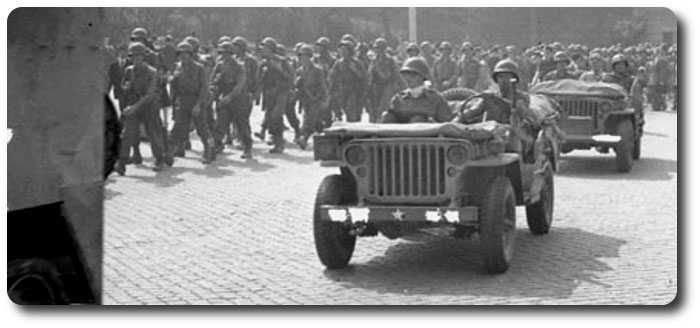
The Montreal Gazette, 10 November 1944
Rome, November 9.—(AP)—Two gangs, composed in part of deserters from the United States and Canadian armies and the French Foreign Legion, have been rounded up by military police after terrorizing Rome and Naples for several weeks, it was announced today.
Allied Headquarters said in an official announcement that the gans were charged with kidnapping military policemen, stealing their motorcycles and committing :many other hold-ups and robberies."
One of the gangs, led by a 23-year-old American soldier from Pennsylvania, was made up entirely of soldiers—six Americans and two Canadians—all absent without leave.
The second, led by a Yugoslav and a Corsican, both deserters from the French Foreign Legion, included five other deserters from the Legion, one American deserter and five Italian and Spanish civilians.
The American and Canadian soldiers face court-martial.
The all-soldier gang is accused of a number of hold-ups and other acts of violence, including the theft of the automobile of Lt.-Gen. Wladyslaw Anders, commander of the Polish Army Corps, and the kidnapping of several military policemen between Rome and Naples.
The break-up of this gang came after a jeep was wrecked in Rome and one of the Canadian members was injured. Military police charged that he carried a revolver taken from an American M.P. on the Rome-Naples road.
A guard was placed on the jeep and that night another Canadian, dressed as a United States officer, and an American dressed as a staff sergeant came to get it. Arrested, they tried to shoot their way out, but were overpowered. The prisoners were found to be ill and they were confined in a Rome hospital.
Then fellow gangsters appeared at the hospital attired as military policemen in an effort to "spring" the prisoners, but police scared them off.
From the three men in custody the police learned about the haunts of the gang and captured four more of the deserters at a Rome cafe.
The larger gang which used U.S. Army weapons as part of its equipment was taken into custody on information from a Spanish civilian.
Lt.-Col. Geoffrey White, deputy provost marshal in Rome, said the fact that many men A.W.L. were stranded in Rome without funds was responsible for the crimes. He said that even though these two gangs were broken up, it was probable that similar gangs in Rome and other cities remained.
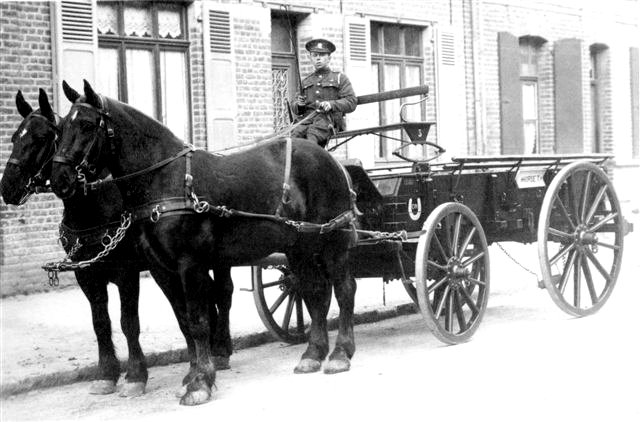
It is very probable that 90 people out of every 100 think of an army as a great aggregation of fighting men, armed to the teeth with rifles, swords and what not, while they never once give a thought to the "men in the rear."
The Pittsburg Press, Pittsburgh, Pennsylvania, 18 April 1900 (From the Detroit Free Press)
It is very probable that 90 people out of every 100 think of an army as a great aggregation of fighting men, armed to the teeth with rifles, swords and what not, while they never once give a thought to the "men in the rear." Yet these men in the rear are an important part of the fighting machinery.
When an army is encamped in a friendly country there is not so great a difficulty in feeding it as when it is penetrating hostile territory and has separated from its own country. And yet in either case it is no light task to furnish and distribute the food that is to keep, say, 30,000 stomachs satisfied and 30,000 hearts in the right place. This is the work of the commissary department.
When an army division or an army corps is encamped at home the problem of getting supplies is comparatively simple. Sometimes they are furnished on contract, sometimes bought in large quantities a week or more in advance of the time at which they will be needed. The commissary general is responsible for the procuring of these supplies and having them deposited at a depot within easy reach of the troops.
Each company of a regiment has its cooks, each regiment has its commissary depot, where supplies are kept sufficient, say, for a week or ten days for all the men. Men are detailed from each company to assist in the work of getting the supplies from the regimental depot to the company kitchens every day. Others are detailed to help transport the supplies to regimental depots from the general headquarters whenever the stores in the former are getting low.
As all supplies are issued from headquarters only on orders and receipts are given for everything secured, it can be seen that there is an immense amount of clerical work necessary to the smooth and uninterrupted work of the department.
When the troops are in barracks the work of the kitchen can be better attended to than in the field. Ranges and all necessary utensils are on hand and hot meals are served to the different mess tables with regularity. When in the field, either field stoves are used for cooking or partially covered trenches are constructed with an opening for the huge coffee kettle and an oven for the baking of bread.
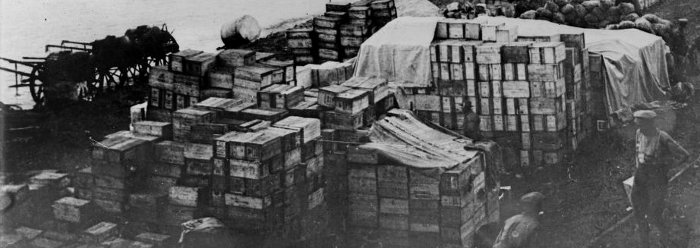
Suppose an army to have landed on a foreign coast. The first move after the landing of the men and arms is to secure a convenient spot for a depot of supplies. These are landed and piled high on the shore until there seems to be a mountain of boxes inextricably mingled in the general mass. Gradually these are separated into different piles and order begins to make its appearance out of chaos, until all the supplies are properly housed.
For an army of 30,000 men and 10,000 horses for three months it is estimated that there are necessary 11,000 tons of food and forage. This must be made up of palatable and strength-giving supplies, with a proper proportion of meat. Vegetables, coffee and flour for bread or biscuits. The meat is generally canned, although sides of bacon are abundant, and even herds of cattle are taken along for fresh meat.
Whenever any important move is to be made by the army each soldier is usually supplied with rations for a day, which he carries in his haversack. These he is not to use unless ordered to do so. There are, besides, two days' rations carried in transport for each fraction of a command to tide the troops over the march. In the English army there are even wagon arrangements for cooking meals on the march, great quantities of soup being heated and meat and potatoes being prepared while on the march. But when the army moves away from its base of supplies then it is that the feeding problem becomes more complicated.
There are always a number of men detailed from each regiment to assist in the work of bringing up supplies. The keeping open of a line of communication with the base of supplies is the first thing that a commander must see to, for it means the safety of his army. If this line of communication is but a day's march, the work is simple, and it does not take many men detailed to wagon driving to replenish the impoverished stock of the regimental or division larder. But when the distance is increased to sixty or one hundred miles the trick is one of great difficulty.
There are along this line of communication two lines of transport wagons constantly on the move and in opposite directions. The one line is for wagons filled with stores and supplies for the army. The other is made up of empty wagons going back to base for other loads. Easy stages are made of the journey.
For instance, one set of loaded wagons will start from the base and go an easy distance, when another lot of empty ones will be coming in the opposite direction. The drivers and horses will be exchanged, those on the loaded wagons returning with the empty ones to the base of supply and those on the empty wagons taking the loaded supplies one stage nearer the army, at the end of which the same thing is repeated which the transportation of supplies and ammunition, too, is being carried on.
Within easy reach of the army is established a second base of supplies where a great amount of stores is accumulated in order to enable the army to extend its operations further from its principal base. Of course, a railroad makes the thing doubly sure and quick. But there is usually a good deal of wagon hauling to be done even with the railroads, because it is not often possible for an army to confine its operations to the line of rail communication. In any case, from the nearest base supplies are brought to the division or regimental wagons, which are filled on requisition and receipts are given for the supplies received.
A week's supply or even ten days' food should be at hand with the army. From the regimental depots the company gets its food for each day, and it is transferred to the company kitchen. Here are great kettles of coffee steaming over the fire, with bacon or other meat steaming in the pans. Thus the food which started as the contents of one of the boxes in the mountain on the shore, finally comes to the plate of the soldier to give him strength.
Sometimes a flying column takes no commissary train with it, cuts itself off from its base of supplies and moves swiftly through the country taking a few days' rations. This cannot be done unless the country is thoroughly known and can be depended on for food.
Sir George Head, writing of his experience in charge of the commissary in the peninsular war, says that 3 o'clock ever morning found him in the presence of the commanding general, where he was told of the movements of the army for the day. He would then go to his own quarters, where he found scores of representatives of the different parts of the army waiting for information. Sometimes, he said, he was obliged to ride out in the rain and scour the country for wheat to be made into flour for that night's distribution.
The worry of such a position can scarcely be imagined, for even after a supply of wheat was found, it had to be transported to mill, ground and carried to a convenient place for distribution among the parts of the army, which operations required the services of many men and teams.
There is considerable red tape required to get provisions, no less than seventy-five different kinds of blanks being supplied to use as requisitions.
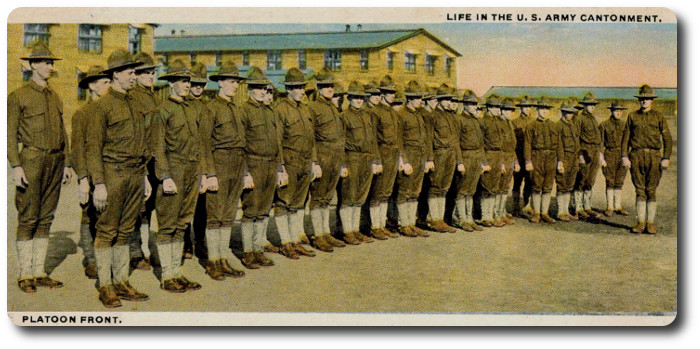
Spokane Daily Chronicle, Spokane, Washington, 5 September 1917
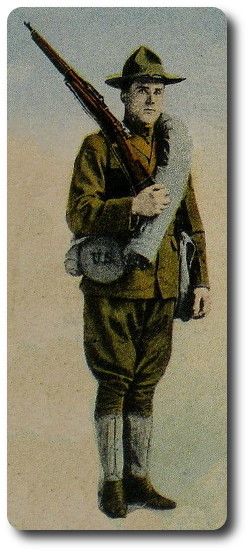 Each soldier in a modern army carries with him sufficient food, clothing, shelter, fighting arms and ammunition to take care of himself for a short period in case he should be separated from his company. The total weight of his load, in addition to the clothes he wears, is 50 to 70 pounds. The number of articles is surprisingly large. They are so devised, however, that by ingenious methods of packing and adjusting they can all be carried with the least possible effort.
Each soldier in a modern army carries with him sufficient food, clothing, shelter, fighting arms and ammunition to take care of himself for a short period in case he should be separated from his company. The total weight of his load, in addition to the clothes he wears, is 50 to 70 pounds. The number of articles is surprisingly large. They are so devised, however, that by ingenious methods of packing and adjusting they can all be carried with the least possible effort.
You are personally responsible for all the arms, clothing, and supplies issued to you.
You will receive on enlistment and ample supply of clothing, including not only your uniform, but extra shoes, shorts, underclothes and socks. You may not be able always to keep your clothes spotlessly clean. But when it becomes dirty or spotted, take the first opportunity to clean it thoroughly.
Your shoes must be cleaned and polished frequently. Wet shoes should be carefully dried.
In general, see to it that all your clothing is as neat and clean as possible at all times. Mend rips and sew on buttons without delay. This will add to your comfort as well as appearance.
Wear your hat straight. Don't affect the "smart aleck" style of tilting the hat. Keep all buttons fastened. Have your trousers and leggings properly laced. Keep yourself clean shaved. Carry yourself like a soldier.
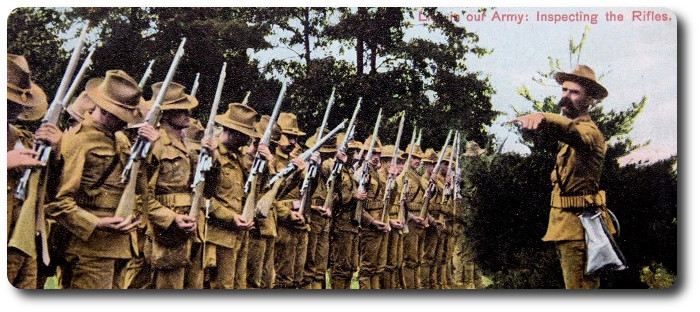
Besides his extra clothing, a soldier carries a blanket, a rubber poncho, a canteen, fork and spoon, a cup, toilet articles, a first-aid package and some minor belongings.
One of the most useful pieces is one-half of a shelter tent, with rope and pins. The shelter tent is said to be a French invention which was introduced into the American army during the civil war.
Two men can combine their halves and set up a shelter tent in a few minutes. While it cannot be described as roomy, it is just what its name implies, a "shelter" from wind and rain. It is used only in temporary camps.
Your chief fighting tools will be a rifle, a bayonet in a scabbard, a cartridge belt, and an intrenching tool. Other weapons or defences needed in modern trench warfare will be referred to later. Do not under any circumstances lose track of these articles while on field duty. So long as you possess them, you are an armed soldier capable of defending yourself and of performing effective service. Without them you are for all practical purposes helpless.
The rifle is the soldier's closest friend. His first thought should be to guard it and care for it above all his other possessions. He expects it to take care of him in emergencies. In ordinary times he must take care of it.
In caring for a rifle it is especially important to keep the bore clean. In so doing be sure to avoid injuring the delicate rifling which causes the bullet to spin as it is forced out and this increases the accuracy of firing. Never put away a rifle that has been fired or exposed to bad weather without first cleaning it. Never lay a rifle flat on the ground. Rest it securely against something.

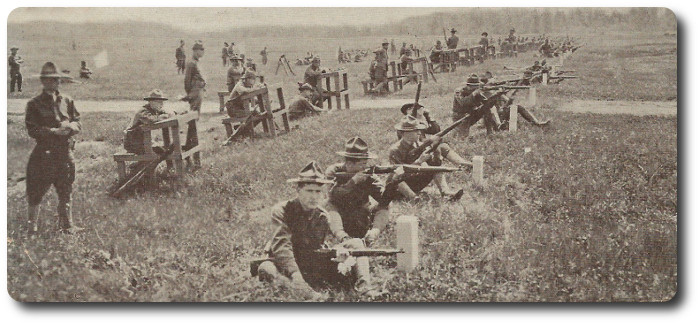
Anybody in normal physical condition can learn to be a good shot. Two of the most important points to remember are to take a deep breath just before completing your aim so that you may hold your rifle with perfect steadiness, and to squeeze the trigger so that the gun will not be jerked from its aim at the moment of firing.
In modern warfare the intrenching tool is an essential part of your fighting equipment. The eight men in each squad carry these eight tools: four shovels, two pick mattocks, one pole or hand ax, and one wirecutter. In ordinary soil you can quickly throw up a shallow trench which will protect you to a great extent from the enemy's fire. After a trench has once been started, it can be deepened and extended, even in the face of the enemy, without the soldier exposing himself to direct fire.

Headquarters. Quebec, 17th March, 1865.
Volunteer Militia Lower Canada
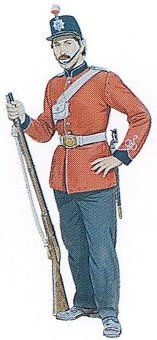 His Excellency the Commander in Chief has been pleased to direct that Captain Hanson's Company, No. 1, of the 1st (Prince of Wales Regiment) of Volunteer Rifles, be removed from the list of Volunteer Militia. The officers and men of this Company having been guilty of a gross act of insubordination, in refusing to obey the orders of the Officer Commanding the Regiment, when directed to equalize the Battalion for inspection by the Inspecting Field Officer, on the 13th December last. An act by which that Company, not only compromised the character of the Regiment to which it belonged, but also that of the Force generally.
His Excellency the Commander in Chief has been pleased to direct that Captain Hanson's Company, No. 1, of the 1st (Prince of Wales Regiment) of Volunteer Rifles, be removed from the list of Volunteer Militia. The officers and men of this Company having been guilty of a gross act of insubordination, in refusing to obey the orders of the Officer Commanding the Regiment, when directed to equalize the Battalion for inspection by the Inspecting Field Officer, on the 13th December last. An act by which that Company, not only compromised the character of the Regiment to which it belonged, but also that of the Force generally.
Obedience to orders, emanating from superior authority, is the first duty of the Volunteer as well as of the Regular soldier, and unless this cardinal principle in military matters is well understood, and fully acted upon, no discipline worthy of the name can ever be maintained. It is to be regretted that with this Company, the warning and admonition, which it received on a previous occasion, for an offense similar in character, should have produced so little effect, as to have rendered it necessary for His Excellency to have to resort to the extreme measure of disbanding the Company, by its repetition in the present instance.
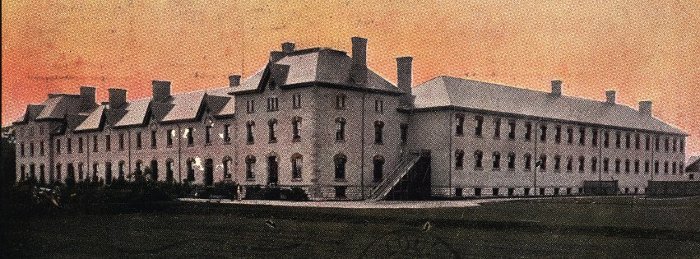
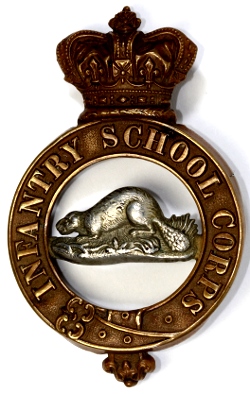 Militia General Orders
Militia General Orders
Headquarters, Ottawa, 29th April, 1892
No. 1
The following changes in the issue of clothing to Permanent Corps will take effect from the 1st May, 1892 .
1. Two serge jackets will be issued in the second year of the soldier's service instead of a tunic, and an alternate issue of one tunic and one serge jacket, or two serge jackets will be continued during the remainder of his service.
2. No special clothing or distinctive marks allowed for privates of the Infantry School employed as bandsmen.
3. Clothing will be issued on fixed dates twice a year as follows:
(a .) "Summer issue" to be made on the 1st April and taken into wear on the 1st May, consisting of—
(b.) "Winter issue" to be made on the 1st September and taken into wear on the 1st October, consisting of—
The interval of one month is allowed to admit of the clothing being fitted, to the satisfaction of the officer commanding the Troop, Battery or Company, before being taken into wear.
4. Men who become entitled to new clothing in the period between the 1st May and 1st October, will receive the summer issue as soon as possible after the first named date . Those who become entitled to the issue between the 1st October, 1892, and the 1st May, 1893, will receive the winter issue for wear on the first named date, and the summer issue similarly on the latter date.
5 . Recruits joining during the course of a summer period will be given the complete summer issue. Those joining during the winter period w ill be given the summer issue (with the exception of summer trousers) in advance. Tunics will in no case be issued to recruits during the period of probation fixed by paragraph 23, Regulations for Permanent Corps .
6. Soldiers whose term of service expires within either of the above mentioned periods will not be issued in advance with new clothing in respect of their uncompleted term of service.
![]()
The Ottawa Citizen, 21 January 1957
The Royal Canadian Navy's new anti-submarine aircraft, the Tracker, is an all-weather, twin-engine high-wing monoplane designed specifically for carrier-borne operations against submarines.
Successor to the Grumman Avenger, which has been in service with the RCN since 1950, the new aircraft, designated the CS2F-1, and to be known as the Tracker, is being built in Canada. Prime contractor for the initial order of 100 aircraft is The de Havilland Aircraft of Canada Limited, Toronto, operating under license from the Grumman Aircraft Engineering Corporation, Beth-Page, N.Y.
These are the first naval aircraft for the RCN to be manufactured in Canada, and the largest ever built by de Havilland of Canada.
The Tracker is both a search and strike aircraft, combining in one machine the full capabilities of hunter and killer. It is designed and equipped to search out, identify, attack and destroy enemy submarines, whether surfaced or submerged. It is highly manoeuverable, has a short take-off run and low landing speed, making it admirably suited for operation from an aircraft carrier. Its versatility permits its use in a number of roles in addition to its primary anti-submarine duties. It may be used for deck-landing training target towing, aircrew training, instrument flying training and carrier-to-shore transport.
Because of the relatively small number of aircraft required, it was considered uneconomical to design and build a Canadian aircraft to meet the RCN's requirements. Of aircraft already in production, the Grumman S2F best met all requirements.

The Canadian version has undergone only minor modifications, although Canadian Navy requirements have resulted in installation of some equipment different from that of its United States counterpart.
Cockpit—To carry out its hunter-killer function the Tracker has accommodation for a crew of four. The pilot and co-pilot have a wide range of vision. The radio and radar men are seated aft of the cockpit which features a folding control console giving ready accessibility to the seats. Each member of the crew has an escape hatch fitted directly above his seat. A control lock has been provided. When this is in operation the engines cannot be revved up sufficiently to raise the aircraft into the air. Also included is the new hydraulic "Rudder boost," which eliminates strain on the pilot during single engine flying. It is one of the first production aircraft to incorporate this new feature.
Instruments—Included in the standard instrument layout is a "safe speed indicator," the first military installation of the device in Canada. The indicator incorporates a dial which shows the pilot the approximate approach speed of the aircraft on landing, whether it is too fast, too slow or just right. Autopilot is fitted.
Anti-Submarine Equipment and Weapons—The latest equipment for the detection of submarines and the most modern anti-submarine weapons are carried. This has been achieved without any sacrifice of speed or endurance. The aircraft is equipped with sonobuoys housed in a special compartment aft of each engine, rockets, homing type torpedoes released through fast opening and closing bomb bay doors, and a powerful searchlight controlled from the cockpit.
During anti-submarine opertions the spun glass radar dome is telescoped down from the inside automatically. The magnetic airborne detection boom is fitted below the tail. The sonobuoys, listening devices which are dropped into the water in the area of a submarine and by radio transmissions reveal the submarine's position to the aircraft, are released by controls located at the pilot's and co-pilot's seats.
Performance—The aircraft has a range of approximately 1,000 miles and can remain airborne for about eight hours. Its maximum speed is more than 300 miles per hour. Landing speed is 86 miles per hour.
Dimensions—Wing span is 69 feet, eight inches, and length 42 feet. The all-up weight is more than 23,000 pounds.
One of the most interesting features of the Tracker is the method of folding the wings. A cross-fold system is used with one wing folding in front of the other. Purpose of the folding wings is to permit close stowage of the aircraft on the flight deck, in the hangar and on the elevators.
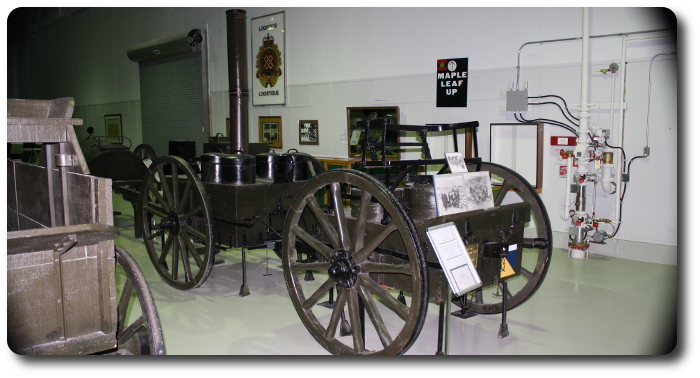
Spokane Daily Chronicle, Spokane, Washington, 23 November 1917
Behind British Lines in France, Nov. 22.—The British army ration scale allows one pound of meat to each man daily to the troops in the trenches, and three-quarters of a pound to those at home. It further requires each soldier at the front to carry a pound of meat in his kit.
The measures by which an army equal to one-fifth of the male population of Great Britain before the war have been supplied with meat on this scale amount to something like a revolution in the technique of army supply.
At the very beginning of the present war it was decided to provide frozen meat for the army and the boards of trade at once entered into negotiations with firms importing meat from the Argentine for a monthly supply of 15,000 tons. Later a "meat committee" was set up, and entrusted with the work of importing meat, not only for the British army, but also for the French and Italian governments, and for the British civil population.
The principal source of supply at present is the Argentine, with assistance from Australia and New Zealand. Both Australia and New Zealand have reserved their entire surplus supply of meat for the use of the imperial government, and over $200,000,000 worth of beef, mutton and lamb has been brought from those countries.
To carry these enormous quantities of meat to the troops the board of trade requisitioned all the shipping engaged in the frozen meat traffic. Some of the meat is taken to England, but the greater part of that required for the armies is landed directly at the base ports, where it is discharged into cold storage warehouses specifically erected for the purpose. In this manner there is delivered monthly 30,000 tons of meat for the British armies and 25,000 tons to the armies of Great Britain's allies.
The cost of this meat up to the beginning of 1916 figured out at an average of about 12 ½ cents a pound, but it has since risen to about 16 ½ cents.
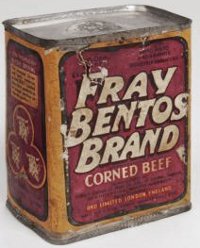 Frozen meat at present constitutes 60 per cent of the total meat issued to the British army. The remainder is made up of preserved meat of several varieties. The most familiar form is the well-known "bully beef," which is corned beef packed in small oblong tins, each containing 12 ounces. Some units cook their bully beef, other prefer it just as it comes from the tin. In comprised the principal article of diet for the army at Gallipoli.
Frozen meat at present constitutes 60 per cent of the total meat issued to the British army. The remainder is made up of preserved meat of several varieties. The most familiar form is the well-known "bully beef," which is corned beef packed in small oblong tins, each containing 12 ounces. Some units cook their bully beef, other prefer it just as it comes from the tin. In comprised the principal article of diet for the army at Gallipoli.
Another form of preserved ration is a combination of about nine ounces of meat and a half pound of potatoes and other vegetables. This is served after warming up, either by heating in the tin or by boiling the contents in a camp kettle, which transfers it into a fairly appetizing stew. This combination, which is known in army parlance as "meat and vegetable ration," is manufactured in England by about 30 firms, working under the inspection of the local government board.
Another form of preserved ration, adopted from the American armies, is pork and beans. The first supplies of these were obtained from the Canadian Pacific Railway company and were introduced on an experimental scale in March, 1916.
The amount of canned meats supplied to the troops in France is enormous. Three and a half million cans are received weekly at the bases, and since the beginning of the war the army contract department has purchased over 400,000,000 cans of preserved meat. These cans would weigh about 178,500 tons, roughly the equivalent is weight of six superdreadnaughts.
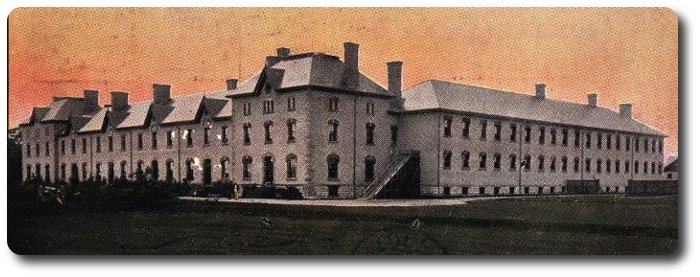
The Daily Telegraph, Quebec, P.Q., 14 October 1897
Major-General Gascoigne says some sarcastic things of the way some officers treat the Royal Infantry Schools, in an order promulgated this week. He takes the commanding officers to task in the following language:
"The general officer commanding has observed that the class of non-commissioned officers and men sent for instruction to these schools is not always creditable to the corps to which they belong, and that proper care is not exercised in their selection. He therefore deems it expedient to remind officers commanding units that these schools of instruction are not maintained for the purpose of affording temporary employment to the unemployed, or for the training of recruits. The regulations and orders for the militia are quite explicit in this respect, and the general officer commanding intends that in future the principles therein defined shall be strictly adhered to in order that due value may be received by the public for the expenditure."
Additional restrictions are presented to provide against a continuation of the abuse. Under them men must have seen 12 months' service, must be intelligent, and qualified for the schools.
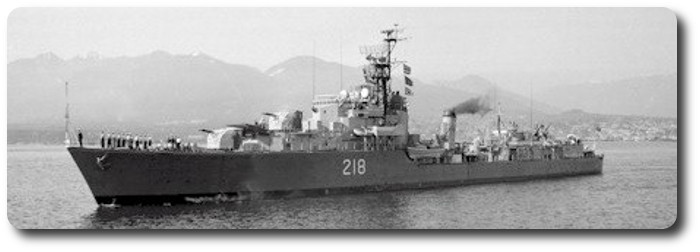
Toledo Blade, Toledo, Ohio, 13 July 1958
By Gerard Waring
Ottawa—One of the matters that President Eisenhower and Prime Minister Deifenbaker discussed here this week was the position of Canada in light of the changes in American law which makes American military atomic science available to Great Britain.
The necessary qualification for receiving U.S. atomic aid is the prior development of atomic weapons by the nation which is to receive the aid. Britain is the only western nation that so qualifies.
For several years Canada has had the financial, scientific and fissile materials resources to produce atomic bombs. But the Canadian government has refrained from entering the atomic arms race and instead has concentrated its not inconsiderable atomic research faciloities on the development of peaceful uses of atomic energy.
,em>But—
Canada now needs atomic weapons, in the form of warheads for ground-to-air and air-to-air missiles rather than bombs, to defend Canada and to help defend the United States in case Russia attacks.

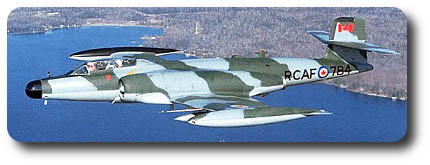 The entire Canadian air defence potential, excluding only a division of jet interceptors stations in Europe, is in process of being put under the operational control of the North American Air Defence Command at Colorado Springs, along with USAF jets.
The entire Canadian air defence potential, excluding only a division of jet interceptors stations in Europe, is in process of being put under the operational control of the North American Air Defence Command at Colorado Springs, along with USAF jets.
The USAF jets are being armed with missiles equipped with atomic warheads. The RCAF's present CF-100 jet interceptors are armed only with rockets and cannon. Plans are to equip Canada's new supersonic jet, the CF-105, with Sparrow missiles developed by the U.S. Navy, but under present circumstances stemming from U.S. law, these missiles will have high explosive, rather than atomic warheads.
The Royal Canadian Navy is faced with a similar handicap. It is an anti-submarine fleet. Its job is to ferret out and sink enemy subs. The evidence is now overwhelming that the best defence against a nuclear sub is another nuclear sub. The Canadian navy is planning to acquire N-subs. But because of the restriction imposed on the U.S. navy by the McMahon Act, the Canadian navy cannot obtain from the U.S. Navy all the information it would like on the design of nuclear submarines. So Canada is working, with British help, on the development of its own atomic subs, needlessly duplicating research the U.S. already has done.
This situation, and the RCAF's lack of atomic warheads, weakens continental defence.
Obviously the new U.S. law was drafted so it would apply to Britain but not to France. For the sake of a roadblock in the way of France becoming the world's fourth atomic power, Canadian fliers may have to defend Chicago and Detroit with outmoded arms, and Canadian sailors to defend Boston and new York with outmoded ships.
The situation becomes more ridiculous in light of two additional facts:
Canada is the chief supplier of fissile materials for the American atomic arms program. Without the production of Canadian mines, the U.S. would be in a much less favorable position in the atoic race with Russia.
There has always been very free exchange of information and personnel between British and Canadian atomic projects, and between British and Canadian armed forces.

But the problem before President Eisenhower here this week was, how could he justify a "yes" to prime Minister Deifenbaker, and a "no" to General De Gaulle? How can the U.S. accept in atomic partnership an ally which has made no effort to develop atomic arms, and refuse such partnership to the French ally, which is very eager to produce its own atomic weapons and become the fourth member, with the U.S., Britain and Russia, of the "atomic club"? It is a dilemma that may not be resolved until France fires its own home-made A-bomb.
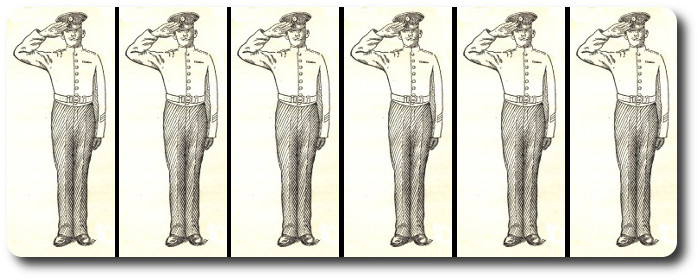
They must be examples at all times to their men, and endeavour constantly to increase their military knowledge.
Notes for Commanding Officers, Issued to Students at the Senior Officers' School, Aldershot, 1917 (5th Course)
1. Non-commissioned officers must not walk out with private soldiers, or associate with them in a familiar way. Their friends must be non-commissioned officers.
2. A non-commissioned officer returning from leave of absence or command should report himself to the Adjutant or the Regimental Quartermaster.
3. Non-commissioned officers must never lend to or borrow money from private soldiers.
4. Sergeants must not enter the men's canteen except on duty. (N.B.—If possible, a place should be arranged for non-commissioned officers, and if no canteen is available, an estaminet should be reserved for them.)
5. Non-commissioned officers must never use harsh or intemperate, and, more particularly, obscene, language to the men.
6. Non-commissioned officers must back up their officers always, and pull together for the honour of their Regiment.
7. In walking out, non-commissioned officers must give an example of dress and smartness. Sergeants wear belt and side-arms; other ranks belts only.
8. They must be examples at all times to their men, and endeavour constantly to increase their military knowledge.
![]() Follow The Regimental Rogue on facebook.
Follow The Regimental Rogue on facebook.
| « | February 2017 | » | ||||
| S | M | T | W | T | F | S |
| 1 | 2 | 3 | 4 | |||
| 5 | 6 | 7 | 8 | 9 | 10 | 11 |
| 12 | 13 | 14 | 15 | 16 | 17 | 18 |
| 19 | 20 | 21 | 22 | 23 | 24 | 25 |
| 26 | 27 | 28 | ||||